Table of Contents
- Introduction
- Editor’s Choice
- Global Motorcycle Helmet Market Overview
- Countries with The Highest Motorbike Use
- Percentage of Motorbike Riders Using a Helmet
- Motorcyclists- By Helmet Type
- Different Motorcycle Injuries Driving the Demand for Helmet Statistics
- Risk Factors
- Motorcycle Helmet-Related Fatalities Statistics
- Violations of Motorcycle Helmet Use Statistics
- Consumer Preferences for Helmets Among Motorcyclists
- Regulations for Motorcycle Helmet Statistics
- Recent Developments
- Conclusion
- FAQs
Introduction
Motorcycle Helmet Statistics: Motorcycle helmets are vital safety gear for riders, with various types available, including full-face, open-face, and modular helmets, each offering different levels of protection.
They consist of an outer shell to absorb impact, an impact-absorbing liner, a comfort liner for padding, and a retention system to secure the helmet.
Safety standards such as DOT, ECE, and Snell ensure helmets meet rigorous requirements. Proper fit and maintenance are crucial, with helmets needing to fit snugly and be regularly inspected for wear and tear.
By understanding these basics, riders can prioritize safety and reduce the risk of head injuries while enjoying their rides.
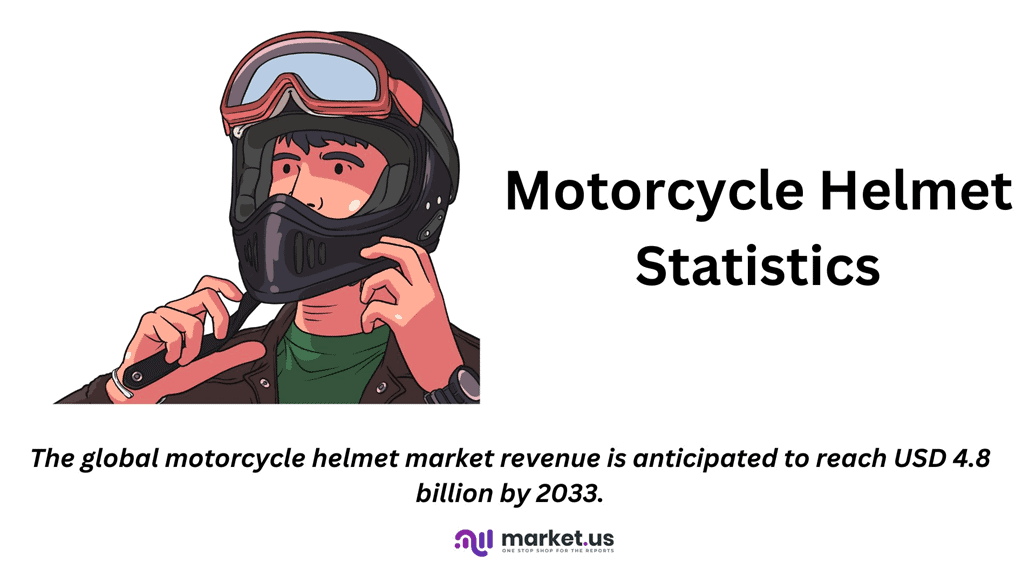
Editor’s Choice
- The global motorcycle helmet market revenue is anticipated to reach USD 4.8 billion by 2033.
- Several key players dominate the motorcycle helmet market, each contributing significantly to the overall market share. HJC Europe S.A.R.L. leads the market with an 18% share.
- The Asia-Pacific (APAC) region dominates with a substantial 40.0% share, reflecting the high demand and large motorcycle user base in this region.
- The percentage of U.S. riders using a helmet decreased to 70.8% in 2019.
- The percentage of motorcyclists wearing DOT-compliant helmets increased from 64.90% in 2021 to 66.50% in 2022, indicating a growing preference for helmets that meet safety standards.
- It was found that 43.30% of the public consistently wears a helmet while driving.
- Price is a significant consideration, with 37.78% strongly agreeing and 35.00% agreeing that it affects their decision.
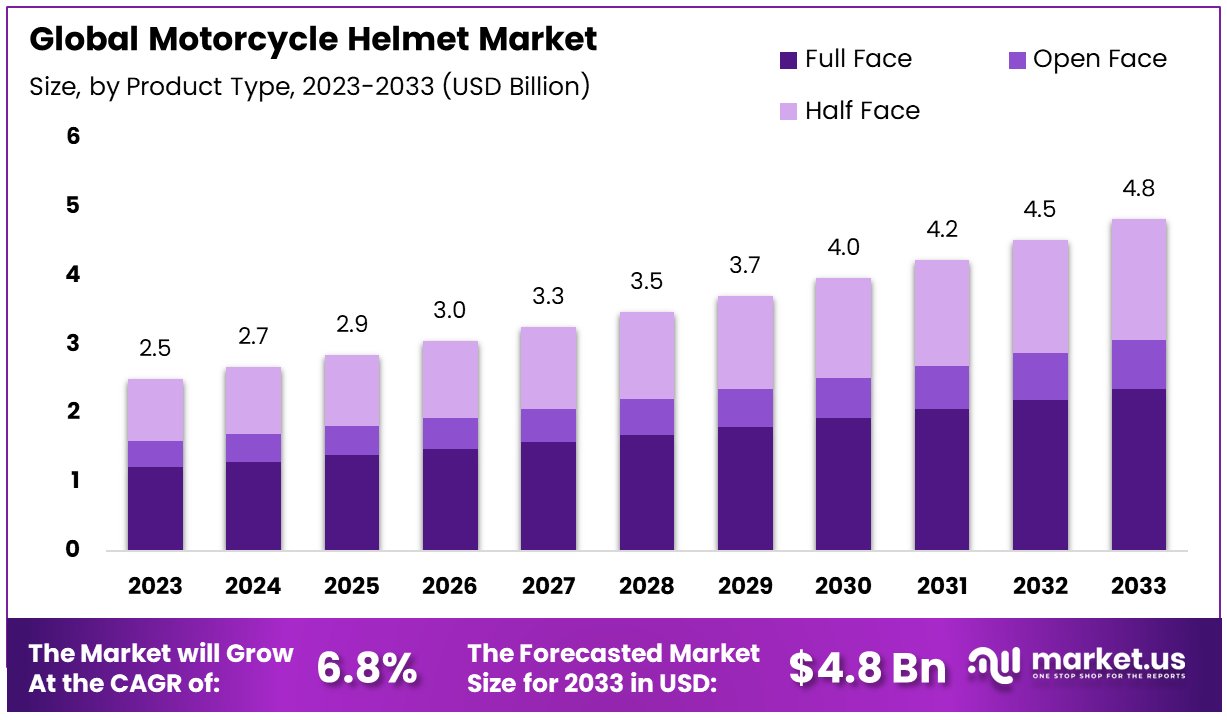
Global Motorcycle Helmet Market Overview
Global Motorcycle Helmet Market Size Statistics
- The global motorcycle helmet market has demonstrated consistent growth over the past decade at a CAGR of 6.80%, with revenue figures reflecting a steady upward trend.
- In 2023, the market revenue stood at USD 2.5 billion.
- Projections indicate continued growth, reaching USD 2.7 billion in 2024 and USD 2.9 billion in 2025.
- By 2026, the market is expected to achieve USD 3.0 billion in revenue, further increasing to USD 3.3 billion in 2027 and USD 3.5 billion in 2028.
- The upward trajectory is anticipated to continue with market revenues of USD 3.7 billion in 2029 and USD 4.0 billion in 2030.
- Looking ahead, the market is forecasted to reach USD 4.2 billion by 2031, USD 4.5 billion by 2032, and USD 4.8 billion by 2033.
- This growth reflects the rising demand for motorcycle helmets, driven by increasing safety awareness and stringent regulations globally.
(Source: market.us)
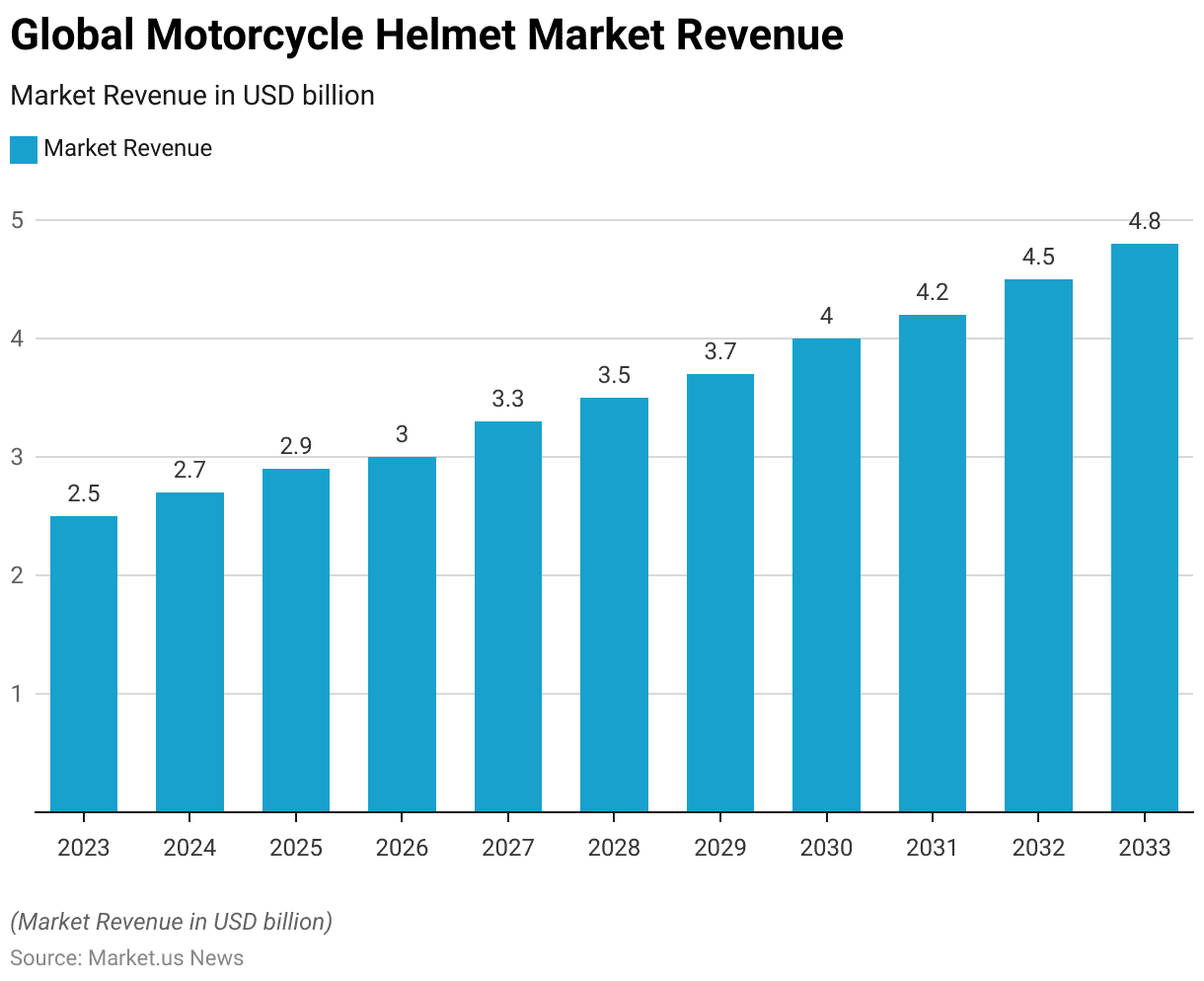
Competitive Landscape of the Global Motorcycle Helmet Market Statistics
- Several key players dominate the motorcycle helmet market, each contributing significantly to the overall market share.
- HJC Europe S.A.R.L. leads the market with an 18% share, followed closely by Dainese SpA at 17%.
- Shoei Co. Ltd and Arai Helmet Ltd hold 9% and 8% of the market, respectively.
- Schuberth GmbH also commands an 8% share, while BELL HELMET captures 7%.
- Both AGV and Suomy each contribute 6% to the market.
- Other key players hold the remaining 2% of the market.
- This distribution highlights the competitive nature of the market, with a few major companies holding substantial portions of the market share.
(Source: market.us)
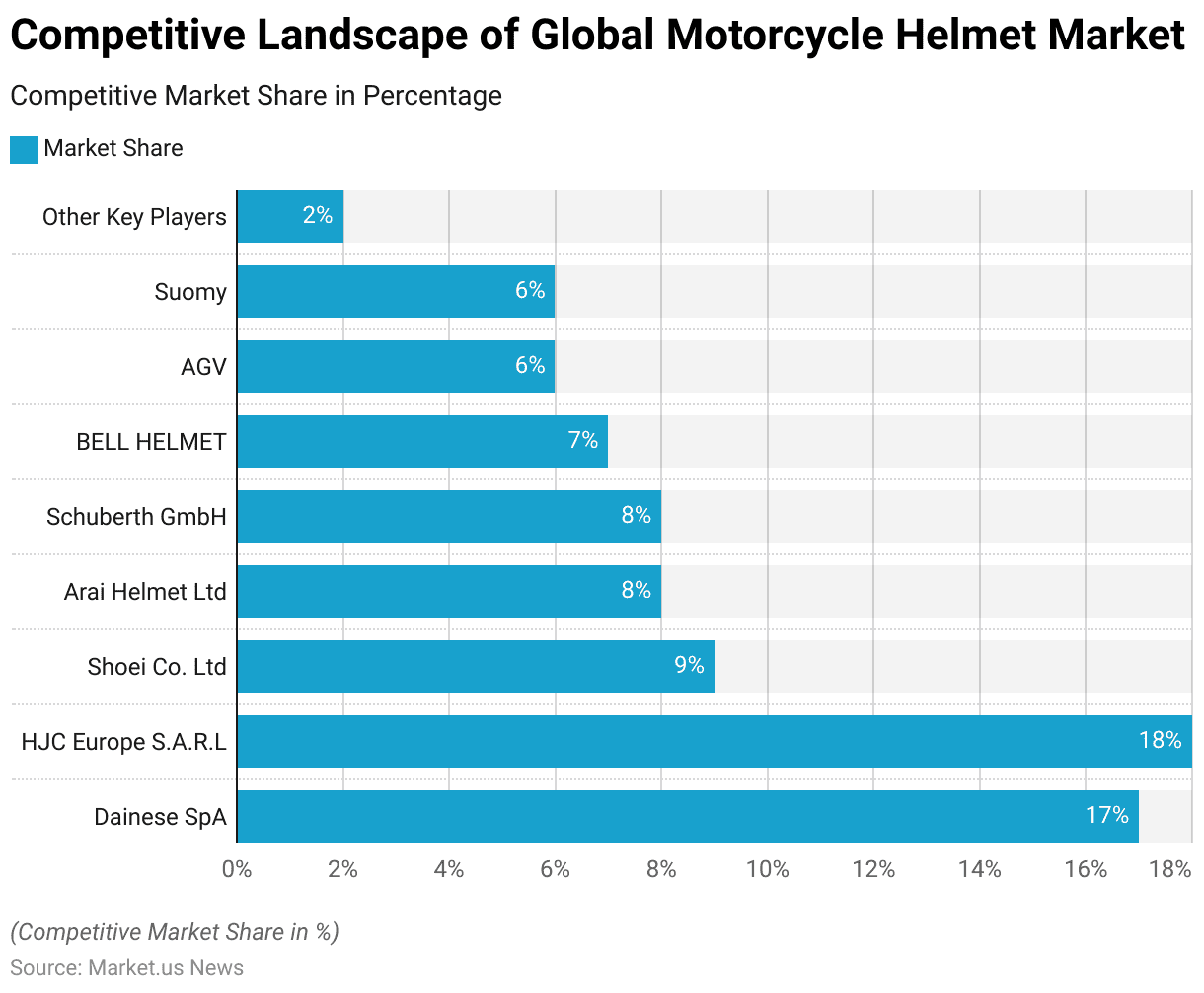
Regional Analysis of the Global Motorcycle Helmet Market Statistics
- The global motorcycle helmet market exhibits a diverse regional distribution of market shares.
- The Asia-Pacific (APAC) region dominates with a substantial 40.0% share, reflecting the high demand and large motorcycle user base in this region.
- North America follows with a 22.0% market share, indicating significant market penetration and consumer awareness regarding helmet safety.
- South America holds a 16.0% share, while Europe accounts for 12.0% of the market.
- The Middle East and Africa (MEA) region contributes 10.0% to the overall market share.
- This regional distribution underscores the varying levels of market maturity and consumer adoption of motorcycle helmets across different parts of the world.
(Source: market.us)
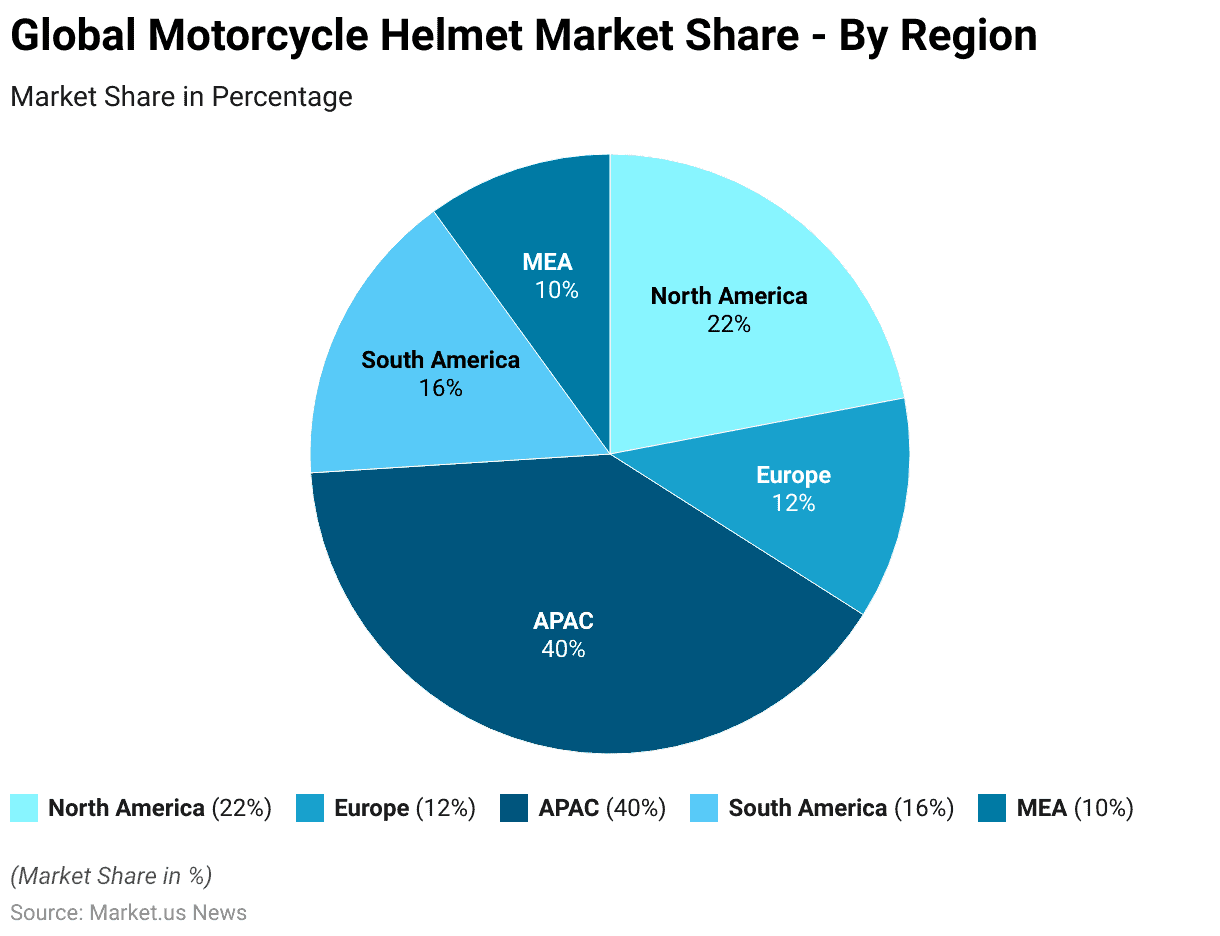
Countries with The Highest Motorbike Use
- Motorbike ownership varies significantly across countries, with the highest percentages observed in Southeast Asia.
- Thailand leads with 87% of households owning a motorbike, closely followed by Vietnam at 86% and Indonesia at 85%.
- Malaysia also shows a high ownership rate of 83%.
- In China, 60% of households own a motorbike, while India and Pakistan have 47% and 43% ownership, respectively.
- In Nigeria, 35% of households own a motorbike, and the Philippines follows with 32%.
- In Brazil and Egypt, motorbike ownership stands at 29% and 28%, respectively.
- Italy has 26% of households owning a motorbike, slightly higher than Tunisia at 25%.
- In Argentina and Colombia, 24% and 23% of households own a motorbike, respectively.
- This data highlights the prevalence of motorbike ownership in various regions, particularly in Southeast Asia, where it is a primary mode of transportation.
(Source: World Atlas)
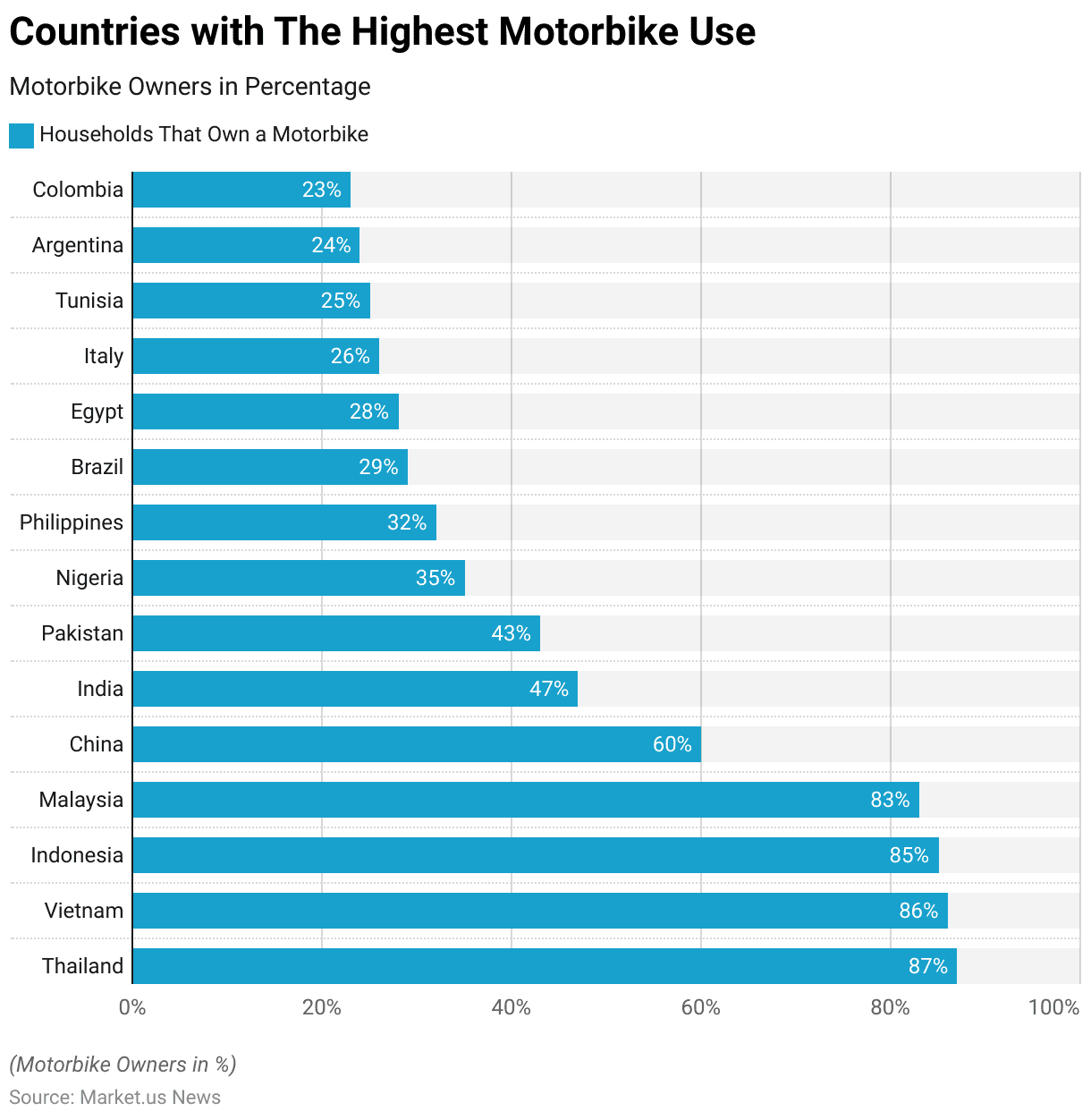
Percentage of Motorbike Riders Using a Helmet
- The percentage of U.S. riders using a helmet has shown fluctuations over the past decade.
- In 2010, helmet usage was at 54.3%, which increased significantly to 66.5% in 2011.
- However, this upward trend did not continue consistently, as the percentage dropped to 60.4% in 2012 and further to 59.5% in 2013.
- A recovery was seen in 2014, with helmet usage rising to 64.3%, followed by a slight decline to 60.7% in 2015.
- The subsequent years saw a steady increase, reaching 65.3% in 2016 and maintaining a similar level at 65.2% in 2017.
- A notable improvement occurred in 2018, with helmet usage climbing to 71.0%, and slightly decreasing to 70.8% in 2019.
- This data indicates an overall positive trend in helmet usage among U.S. riders despite some annual variations.
(Source: U.S. Department of Transportation National Highway Traffic Safety Administration (NHTSA))
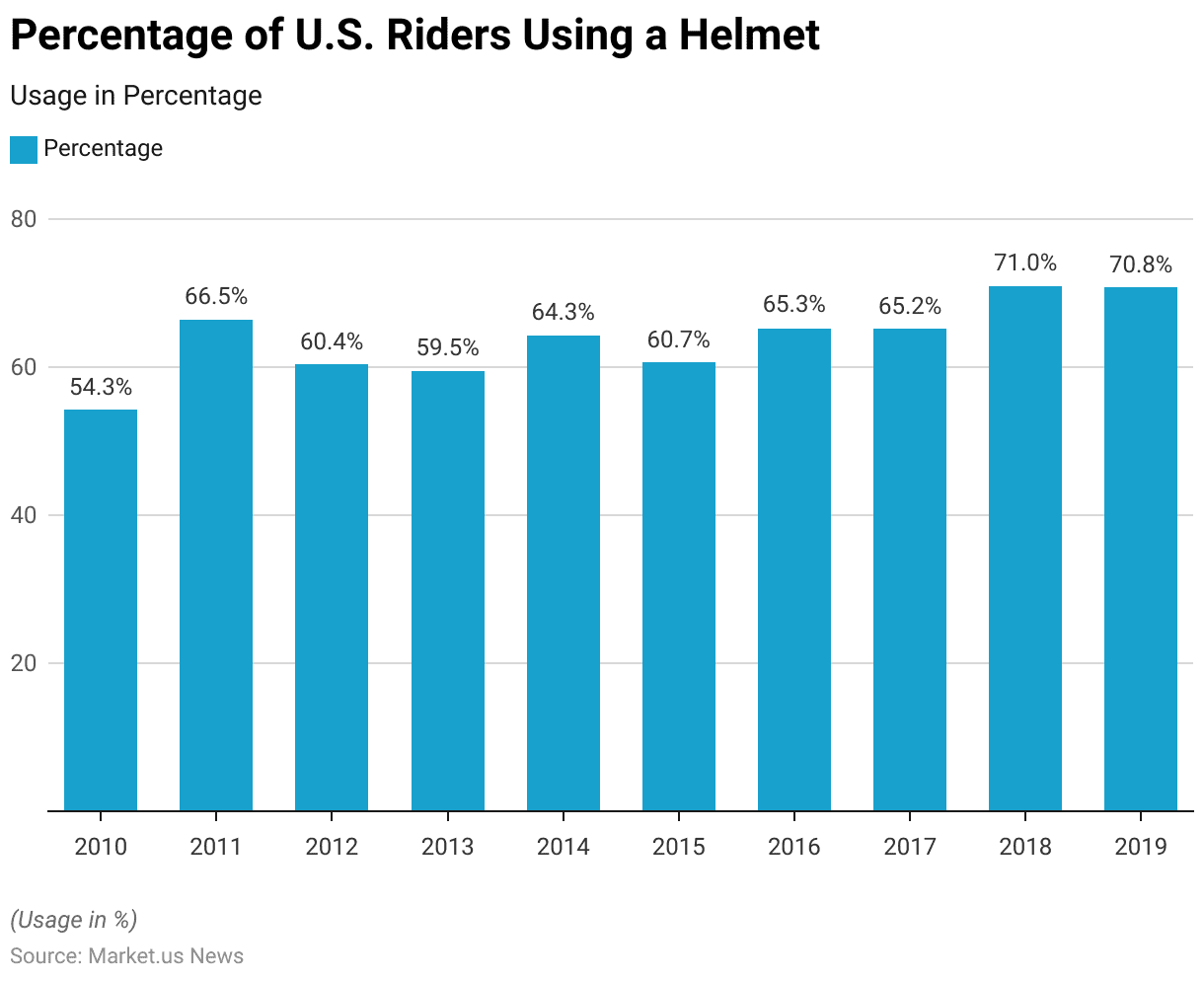
Motorcyclists- By Helmet Type
- In the comparison of helmet usage among motorcyclists between 2021 and 2022, there has been a noticeable shift.
- The percentage of motorcyclists wearing DOT-compliant helmets increased from 64.90% in 2021 to 66.50% in 2022, indicating a growing preference for helmets that meet safety standards.
- Conversely, the usage of non-compliant helmets rose from 5.70% to 9% over the same period.
- There was also a decline in the number of motorcyclists not wearing helmets at all, decreasing from 29.40% in 2021 to 24.50% in 2022.
- These trends suggest an overall improvement in helmet safety compliance among motorcyclists, though the rise in non-compliant helmet usage warrants attention.
(Source: U.S. Department of Transportation National Highway Traffic Safety Administration (NHTSA))
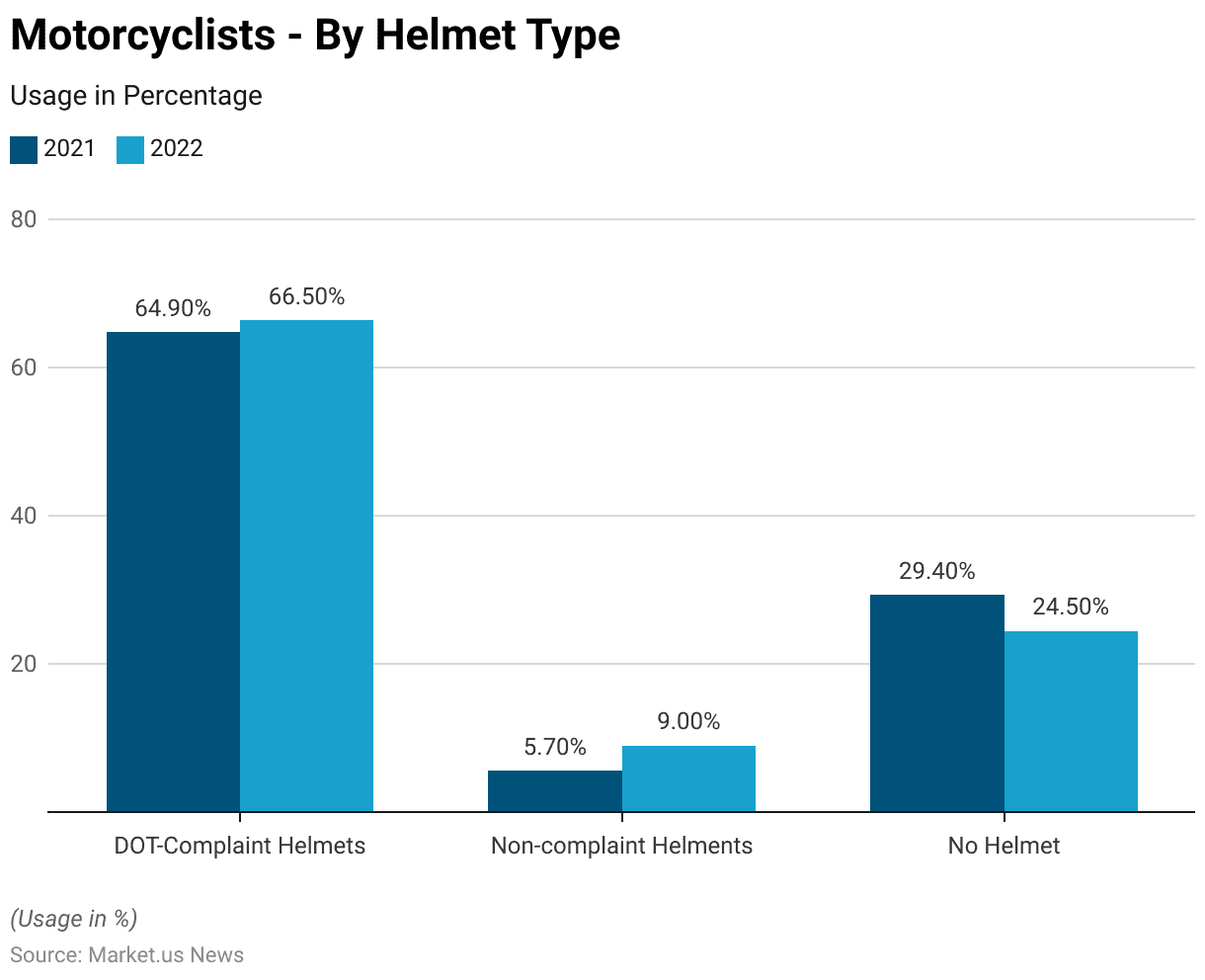
Different Motorcycle Injuries Driving the Demand for Helmet Statistics
- Motorcycle riding carries undeniable risks, as riders face significantly higher fatality and injury rates compared to other drivers.
- In the United States in 2021, 83,000 motorcyclists were injured, averaging 468 injuries per 100 million vehicle miles traveled.
- A concerning factor is the involvement of unlicensed riders, contributing to 36% of fatal motorcycle accidents.
- These incidents vary throughout the year, with August being the most dangerous month, accounting for 12% of fatal crashes, while January is the safest at 3%.
- Despite motorcycles comprising only 3% of registered vehicles, they are involved in 14% of all traffic fatalities and cause 3% of injuries to vehicle occupants.
(Source: Forbes)
Risk Factors
- Not wearing a helmet poses a significant risk to motorcycle riders, with 2,251 fatalities recorded in accidents where helmets were not worn. Helmets offer crucial protection against head injuries, which have high fatality rates.
- Speeding is another major risk, with over a third of fatal motorcycle accidents (34%) involving excessive speed. Speeding increases the likelihood of collisions due to longer stopping distances and reduced control, amplifying the chances of fatal outcomes.
- Alcohol-impaired driving is a well-known hazard, contributing to more than a quarter (27%) of deadly motorcycle accidents. This includes single-vehicle crashes, which comprised 41% of alcohol-related motorcycle accidents and led to 880 rider deaths in 2020.
- Evening hours witness a surge in drunk driving incidents, making it a particularly difficult time for motorcycle accidents.
- Forty percent of alcohol-related motorcycle crash deaths occur during the evening, with accidents three times more likely to involve an impaired driver at night compared to daytime.
- Weekend evenings pose heightened risks, with 24% of fatal motorcycle accidents occurring between 6 and 9 p.m., resulting in 676 deaths.
- Weekdays see crashes happening earlier, with 26% of fatalities between 3 p.m. and 6 p.m., totaling 1,263 deaths during this timeframe.
(Source: Forbes)
Motorcycle Helmet-Related Fatalities Statistics
- The failure of the 2023 subcommittee bill brought relief to safety advocates in the U.S.
- In 2021, there was a record-breaking 6,084 motorcycle fatalities, a 21% surge from 2019, comprising 14% of all motor vehicle accident deaths, nearly three times the 1997 figure.
- Helmets were credited with saving 1,872 lives, with an estimated 749 additional lives that could have been saved if all riders wore helmets.
- Helmet usage led to a 37% reduction in motorcyclist fatalities and a 41% reduction in passenger fatalities.
- Despite motorcycles representing only 3% of registered vehicles, they accounted for 14% of traffic fatalities, with motorcycle crashes resulting in 18% of occupant deaths and 4% of occupant injuries.
- In 2017, helmet compliance was 65.2%, rising to 87% in states with mandatory laws and dropping to 43.7% in others.
- Fatality helmet usage rates varied in 2018, from 89% in states with universal laws to 26% in states without helmet laws.
- The overall helmet usage rate was 71% in 2018, with 83% in states with mandatory laws and 56.9% in others.
- In 2017, helmet usage rates were 62% for motorcyclists and 41% for passengers, which decreased slightly in 2018 to 60% and 51%, respectively.
- Nationwide, in 2017, 39% of motorcycle fatalities occurred without helmets, varying by state from 0% to 76%.
- Helmet usage rates in fatal collisions ranged from 62% to 100% in states with universal laws and from 24% to 60% in states without such laws.
(Source: Maryland Accident Lawyer Blog)
Violations of Motorcycle Helmet Use Statistics
- Violations of helmet use among riders and pillion riders per 100 person-minutes of observation reveal significant non-compliance.
- Among riders, 6.9 violations were recorded for not wearing a helmet, compared to 17.9 violations among pillion riders, resulting in an overall rate of 12.4 violations.
- The use of non-standard helmets was observed in 27.1 riders and 14.5 pillion riders, with a total of 20.8 violations.
- Violations for not wearing a full-face helmet were 6.8 for riders and 5 for pillion riders, averaging 5.9.
- Improper helmet use was noted in 15.8 riders and 7.7 pillion riders, culminating in 11.8 violations.
- Lastly, ineffective helmet use was observed in 21.5 riders and 12 pillion riders, totaling 16.7 violations.
- These statistics underscore the varied and frequent lapses in proper helmet usage among motorcyclists.
(Source: Biomed Central)
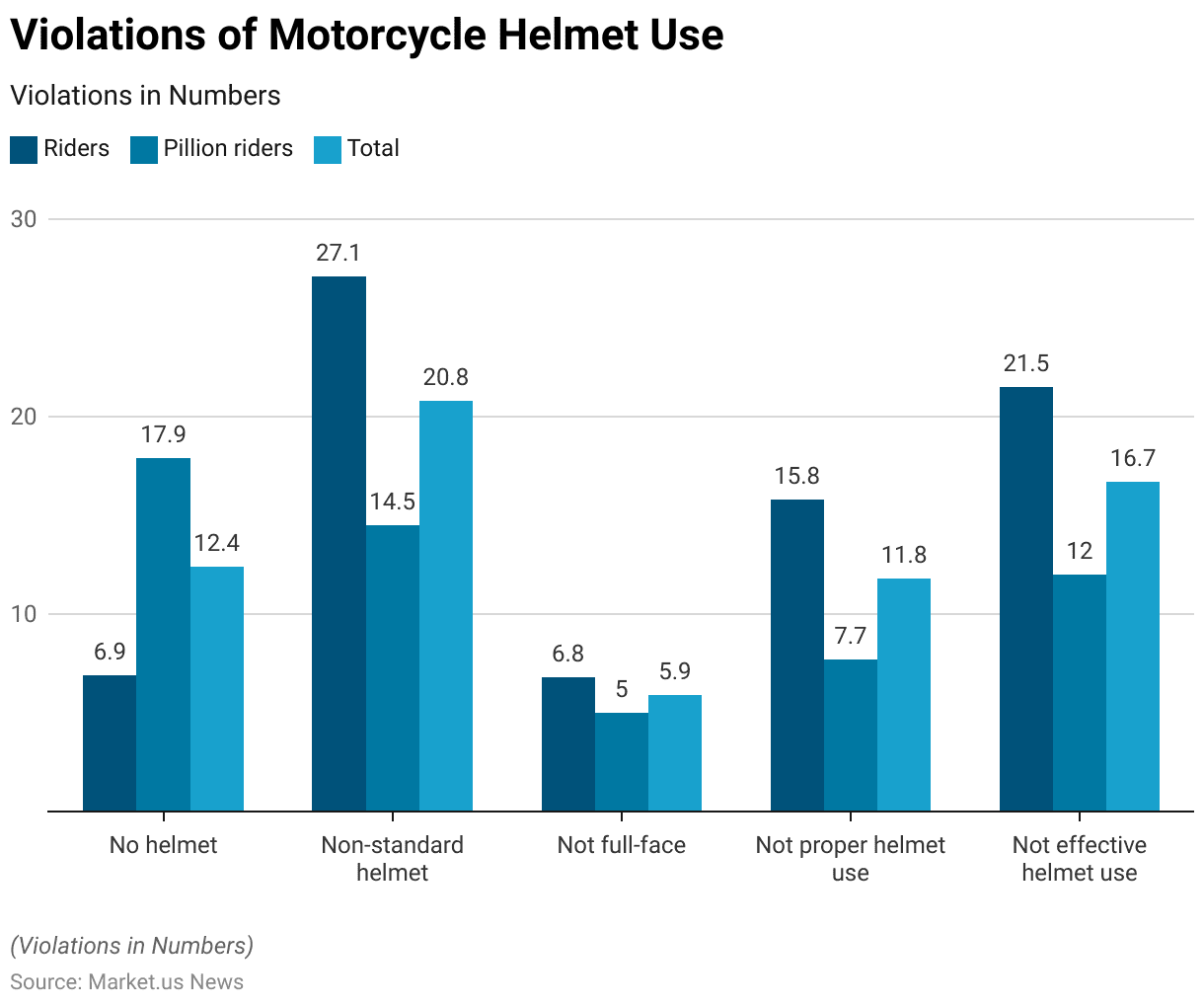
Consumer Preferences for Helmets Among Motorcyclists
Habits of Using Helmet
- It was found that 43.30% of the public consistently wears a helmet while driving.
- Additionally, 38.40% of individuals have the habit of wearing a helmet only at certain places.
- Meanwhile, the remaining 18.30% use a helmet exclusively when driving for adventure purposes.
- This data highlights the varying levels of helmet usage habits among the public, indicating a need for increased awareness and consistent helmet use for safety.
(Source: RK University, Rajkot)
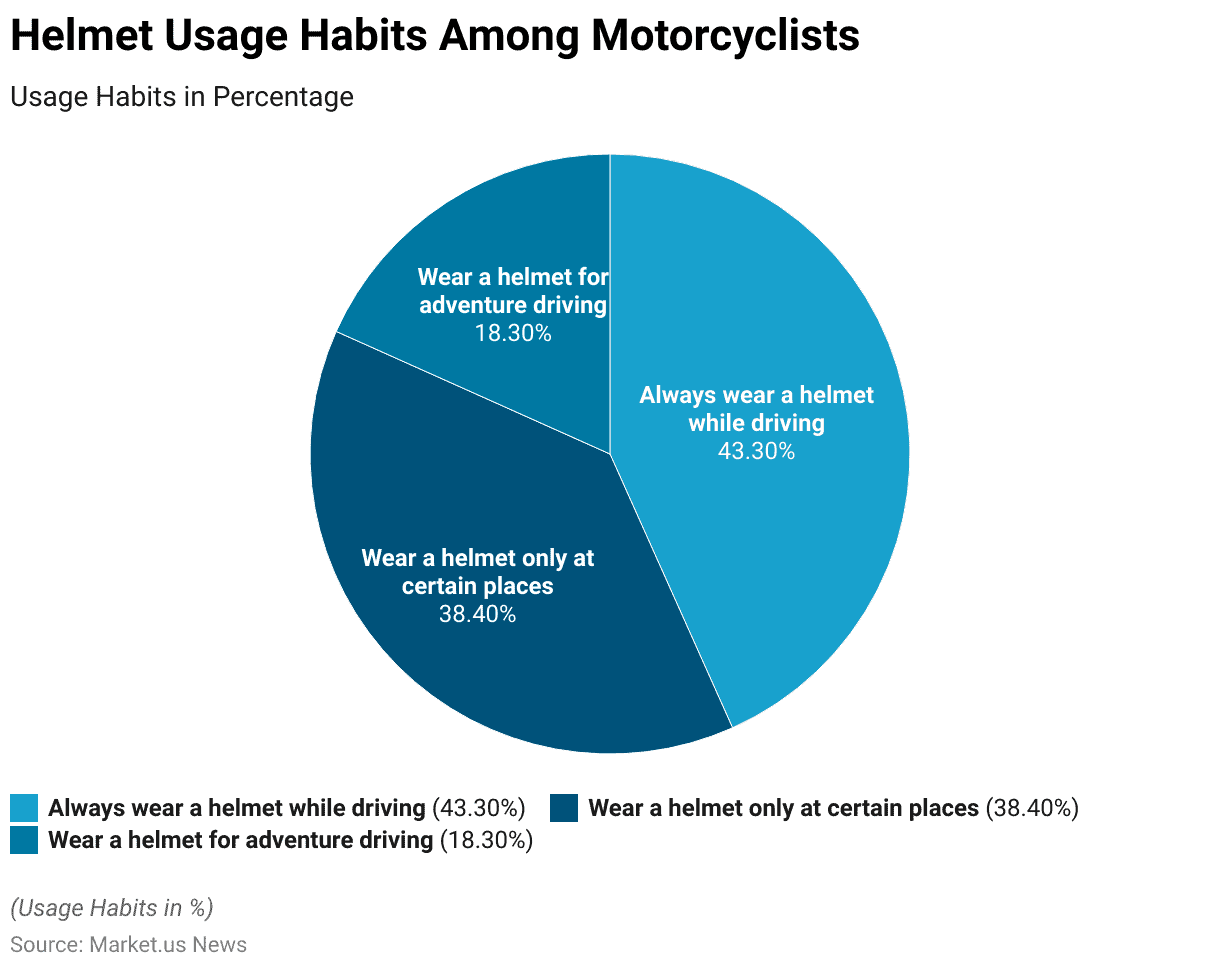
Factors Influencing the Choice of Helmet or While Purchasing a Helmet Among Motorcyclists
- Various factors influence motorcyclists’ choices when purchasing a helmet.
- Price is a significant consideration, with 37.78% strongly agreeing and 35.00% agreeing that it affects their decision.
- Suitable color according to gender is important to 35.56% who strongly agree and 32.78% who agree. Brand name is also influential, with 36.11% strongly agreeing and 32.22% agreeing.
- The helmet’s availability in the market is crucial, as 40% strongly agree and 41.11% agree.
- The easy eject helmet removal system is highly valued, with 48.33% strongly agreeing and 40.56% agreeing.
- Reflective material is another key factor, with 37.22% strongly agreeing and 35.00% agreeing.
- Design influences 31.67% who strongly agree and 33.89% who agree.
- Comfort level is paramount, with 66.67% strongly agreeing.
- The presence of an ISI mark is essential for 65.00% who strongly agree.
- Warranty or guarantee information is significant to 45.00% who strongly agree, and durability is a critical factor for 54.44% who strongly agree.
- These insights highlight the multifaceted considerations motorcyclists take into account when selecting a helmet.
(Source: RK University, Rajkot)
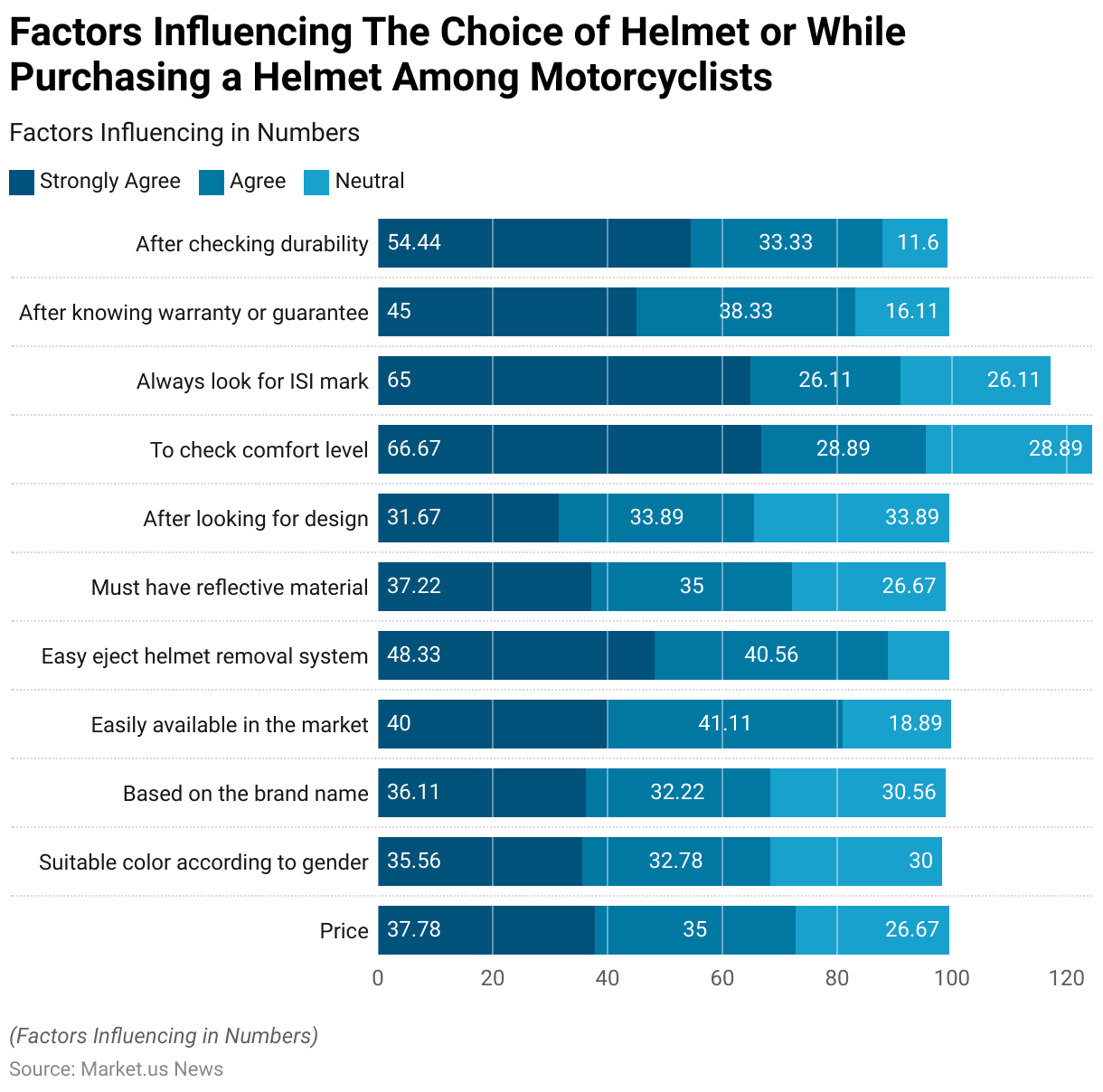
Regulations for Motorcycle Helmet Statistics
- Regulations for motorcycle helmets vary by country, ensuring rider safety through different standards and requirements.
- In the United States, the Department of Transportation (DOT) mandates helmets meet FMVSS 218 standards, which focus on impact protection.
- Additionally, the Snell Memorial Foundation provides voluntary but more rigorous standards for higher safety assurance.
- In Europe, the Economic Community Europe (ECE) 22.06 standard has replaced the older 22.05 standard, emphasizing rotational impact protection and more stringent testing for durability and visor safety.
- Countries like France, Italy, and Germany require all motorcycle helmets to comply with the ECE 22.06 standard.
- Meanwhile, in Japan, helmets must meet the Japanese Industrial Standards (JIS).
- In Australia, the Australian/New Zealand Standard (AS/NZS) 1698-2006 is mandatory.
- In the UK, helmets must adhere to ECE 22.06 standards, and retailers have until 2023 to sell off older 22.05 helmets.
- This global landscape of helmet regulations highlights the emphasis on rider safety and the adaptation of evolving safety standards across different regions.
(Sources: Ultimate Motorcycling, Insurance Institute for Highway Safety (IIHS), Billy’s Scrash Helmets, Bike Rated)
Recent Developments
Acquisitions:
- Steelbird Helmets’ Expansion: In March 2024, Steelbird Hi-Tech India announced plans to invest USD 2.5 billion in setting up a new manufacturing facility in Hosur, Tamil Nadu. This facility aims to meet the growing demand from OEMs (Original Equipment Manufacturers) and the aftermarket.
New Product Launches:
- Caberg S.p.a. Levo X Helmet: In March 2023, Caberg S.p.a. launched the Levo X, a new flip-up/modular motorcycle helmet available in three variants: carbon, manta, and standard. This helmet aims to offer enhanced safety and comfort features for riders.
- Givi’s X.27 Tourer Helmet: In February 2024, Italian manufacturer Givi introduced the X.27 Tourer model, an off-road motorcycle helmet designed for adventure touring. It features a design intended to remain comfortable over long distances, suitable for both on- and off-road capabilities.
- Bell Helmets’ Falcon XR and XRV: In July 2022, Bell Helmets released the Falcon XR and Falcon XRV helmets with MIPS technology, aimed at providing advanced safety features for riders.
Funding:
- Investment in Production Capacity: Several companies are expanding their production capabilities to meet increasing demand. For instance, investments are being made to establish new manufacturing plants and enhance existing facilities, particularly in regions with high motorcycle usage like India and Southeast Asia.
Market Growth:
- Global Market Expansion: The growth is driven by increasing road safety awareness and stricter government regulations mandating helmet use.
- Regional Insights: The Asia-Pacific region, particularly India and China, dominates the global market due to high motorcycle ownership rates and stringent safety regulations. The North American market is also expected to grow significantly, driven by high safety standards and a strong presence of major helmet manufacturers.
Innovation and Trends:
- Integration of Advanced Materials and Technologies: Modern helmets are increasingly made from advanced materials like carbon fiber and fiberglass-reinforced plastic, which make them lighter and safer. Additionally, many helmets now include cutting-edge communication technologies like Bluetooth, enhancing rider convenience and safety.
- Online Sales Growth: The online segment is expected to grow at the highest CAGR due to the convenience of shopping and flexible payment options. E-commerce platforms are becoming significant distribution channels for motorcycle helmets, offering a wide range of products and exclusive deals.
Conclusion
Motorcycle Helmet Statistics – In conclusion, the motorcycle helmet industry thrives on stringent safety regulations and increasing consumer awareness.
Technological advancements are reshaping helmet design with lightweight materials and integrated features driving innovation.
Comfort and style are becoming significant factors in consumer choice, prompting manufacturers to focus on ventilation, fit, and aesthetics.
Smart helmet technology, including heads-up displays and connectivity features, represents a growing trend.
Emerging markets offer untapped potential, but challenges like counterfeit products and affordability persist.
Overall, the industry’s future hinges on addressing safety concerns, embracing innovation, and seizing market opportunities to sustain growth and competitiveness.
FAQs
Key features to look for include proper fit, certification to relevant safety standards, good ventilation, comfort, and additional features like visor clarity, ease of removal, and integrated communication systems. Helmets should also have a secure chin strap and be lightweight yet durable.
Full-face helmets provide the most comprehensive protection as they cover the entire head and face. Modular helmets, also known as flip-up helmets, have a movable chin bar that can be lifted, offering more convenience but slightly less protection than full-face helmets when the chin bar is up.
Yes, many countries and regions have laws mandating helmet use. In the U.S., helmet laws vary by state, with some states requiring helmets for all riders and others only for certain age groups or not at all. In Europe, helmets are generally required for all riders.
Wearing a motorcycle helmet is crucial because it significantly reduces the risk of head injuries and fatalities in the event of an accident. Helmets are designed to absorb impact energy and protect the skull and brain from severe trauma.
Motorcycle helmets should generally be replaced every five years or immediately if they have been involved in a significant impact, even if no visible damage is present. The materials inside the helmet can degrade over time, reducing its effectiveness.
Discuss Your Needs With Our Analyst
Please share your requirements with more details so our analyst can check if they can solve your problem(s)





